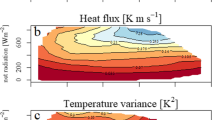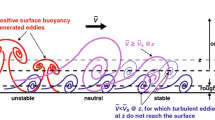Summary
From upper-air network data and NMC tropical wind analyses over the West Pacific . during July 1972 and July 1975, the kinetic energy balance in large-scale disturbances and in the general flow of the tropical circulation was calculated. During July 1972, when an active monsoon and its attendant intertropical convergence zone (ITCZ) dominated much of the tropical West Pacific and five typhoons and a depression formed in the area under study, cross-isobaric generation of the eddy kinetic energy took place in the upper (300 to 100 mb) and lower troposphere (1000 to 700 mb), with weak dissipation at middle levels. The total amount of eddy kinetic energy produced in the area during July 1972 was five times greater than during July 1975, when strong southeast trade winds prevailed over most of the West Pacific and no typhoons formed in that area. In the 1972 case, a significant portion of the generated eddy kinetic energy was exported out of the region, whereas in the 1975 case the area imported a considerable amount of eddy kinetic energy to compensate for dissipation mainly in the upper troposphere. For the month with an active monsoon regime the eddy conversion from available potential to kinetic energy, -[ω*α*], was large, with a maximum in the layer 500 to 200 mb, due to the strong convective warming, whereas for the month with a prevailing trade-wind regime only weak positive eddy conversion (increase of eddy kinetic energy) took place in the lower troposphere, with a considerable portion of the troposphere being dominated by negative eddy conversion.
The kinetic energy balance in the general flow of the two contrasting periods revealed opposite behavior. The budget for July 1972 was characterized by cross-isobaric destruction of kinetic energy in the whole troposphere, with a maximum at middle levels, and with a negative dissipation term which compensated for the cross-isobaric destruction through the interaction between the grid-scale flow and subgrid scale disturbances. In contrast, the cross-isobaric generation and positive dissipation term constituted a balance of kinetic energy in July 1975.
Zusammenfassung
Aus Radiosondendaten und Analysen des National Meteorological Center (NMC) wurden für July 1972 und 1975 über dem Westpazifik die kinetischen Energiebilanzen in großräumigen Störungen und in der Mittelströmung der tropischen Zirkulation berechnet. Im Juli 1972 wurde der tropische Westpazifik von einer aktiven Monsunperiode und der damit zusammenhängenden intertropischen Konvergenzzone (ITCZ) beherrscht. Dabei bildeten sich in dem Beobachtungsraum fünf Taifune und eine tropische Depression. Kinetische Energie wurde hauptsächlich in der oberen Troposphäre (300 bis 100 mb) und in der unteren Troposphäre (1000 bis 700 mb) durch Strömung quer zu den Isobaren erzeugt, während in der mittleren Troposphäre schwache Dissipation kinetischer Energie beobachtet wurde. Der Gesamtbetrag der im Juli 1972 erzeugten kinetischen Energie war fünfmal so groß als der im Juli 1975 erzeugte Betrag, während ein starker Südwestpassat den größten Teil des tropischen Westpazifik überlagerte und sich keine Taifune im Beobachtungssgebiet bildeten. Im Studienbeispiel 1972 wurde ein signifikanter Anteil der erzeugten kinetischen Energie aus dem Beobachtungsgebiet abtransportiert, während im Falle 1975 ein beachtlicher Betrag kinetische Energie in das Gebiet eingeführt wurde, um die hauptsächlich in der oberen Troposphäre auftretende Dissipation zu kompensieren. Während des von einem aktiven Monsun beherrschten Monats war die Umwandlung von verfügbarer otentieller Wirbelenergie, -[ω*α*], verhältnismäßig groß, mit einem Maximalbetrag in der Schicht zwischen 500 und 200 mb, hauptsächlich hervorgeführt durch konvektive Erwärmung. Der Monat mit vorherrschendem Passatregime hingegen wies nur eine geringfügige Umwandlung von Wirbelenergie (Zunahme von kinetischer Wirbelenergie) auf, die in der unteren Troposphäre auftrat. Ein beträchtlicher Teil der Troposphäre wurde von negativer Wirbelenergiekonversion beherrscht.
Die kinetische Energiebilanz der Mittelströmung zeigte während der beiden einander gegenübergestellten Perioden sehr unterschiedliches Verhalten. Die Bilanz im Juli 1972 wurde in der gesamten Troposphäre durch Zerstörung kinetischer Energie in einer Strömung quer zu den Isobaren gekennzeichnet. Maximalwerte traten in mittleren Niveaus auf, wobei ein negativer Dissipationsterm für diese Energiezerstörung durch Querströmung kompensierte und ein Zusammenwirken von klein- und großräumigen Störungen andeutete. Im Gegensatz dazu hielten sich die Energieerzeugung durch Strömung quer zu den Isobaren und ein positiver Dissipationsterm im Juli 1975 annähernd die Waage.
Similar content being viewed by others
References
Chen, Lianshan, Ding Yihui: Introduction to Western Pacific Typhoons, 491 pp. Peking: Science Press 1979. (In Chinese.)
Ding, Yihui, Fang Huijun, Zue Qiufang, and Chen Guixiang: Preliminary Study on Simultaneous Development of Typhoons within the ITCZ. Scientia Atmospherica Sinica1, 89–98 (1977).
Eddy, A.: The Objective Analysis of Horizontal Wind Divergence Field. Quart. J. R. Met. Soc.90,426–440 (1964).
Gray, W. M.: Hurricanes: Their Formation, Structure and Likely Role in the Tropical Circulation. In: Meteorology over the Tropical Oceans (Shaw, D. B., ed.). Roy. Met. Soc. Brackwell, Britain (1979).
Kung, E. C.: Balance of Kinetic Energy in the Tropical Circulation Over the Western Pacific. Quart. J. R. Met. Soc.101, 293–312 (1975).
Kung, E. C., Merritt, L. P.: Kinetic Energy Sources in Large-Scale Tropical Disturbance Over the Marshall Islands Area. Mon. Weath. Rev.102, 489–502 (1974).
Kung, E. C., Burgdorf, H. A.: Maintenance of Kinetic Energy in Large-Scale Tropical Disturbances Over the Eastern Atlantic. Quart. J. R. Met. Soc.104, 393–411 (1978).
Nitta, T.: On the Role of Transient Eddies in the Tropical Troposphere. J. Met. Sec. Japan48, 348–359 (1970).
Norquist, D. B., Recker, E. E., Reed, R. Y.: The Energetics of African Wave Disturbances as Observed During Phase II of GATE. Mon. Weath. Rev.105, 334–342 (1977).
O'Brien, J. J.: Alternative Solution to the Classical Vertical Velocity Problem. J. Appl. Met.9, 197–203 (1970).
Rao, G. V.: Preliminary Estimates of Energy Conversion in a Weak Disturbance in the Easterlies. J. Appl. Met.9, 3–12 (1970).
Reiter, E. R.: Atmospheric Transport Processes. Part l: Energy Transfers and Transformations. AEC Critical Review Series. National Technical Information Service, U.S. Department of Commerce, TID-24868, 253 pp. (1969).
Riehl, H.: A Subtropical Episode of Production of Kinetic Energy from Condensation Heating. Arch. Met. Geoph. Biocl., Ser. A31, 167–183 (1982).
Robertson, F. R., Smith, P. J.: The Kinetic Energy Budgets of Two Severe Storm Producing Extratropical Cyclones. Mon. Weath. Rev.108, 127–143 (1980).
Sadler, J. C.: Mid-season Typhoon Development and Intensity Changes and the Tropical Upper Tropospheric Trough. Mon. Weath. Rev.106, 1136–1152 (1978).
Sadler, J. C., Oda, L., Kilonsky, B. J.: Pacific Ocean Cloudiness from Satellite Observations. Part 1. Department of Meteorology, University of Hawaii, 1976.
Smith, P. J.: An Analysis of Kinetic Vertical Motions. Mon. Weath. Rev.89, 715–724 (1971).
Wallace, J. M.: Spectral Studies of Tropospheric Wave Disturbances in the Tropical Western Pacific. Rev. Geoph. and Space Phys.9, 557–612 (1971).
Ward, J. H., Smith, P. J.: A Kinetic Energy Budget Over North America During a Period of Short Synoptic Wave Development. Mon. Weath. Rev.104, 836–848 (1976).
Author information
Authors and Affiliations
Additional information
With 12 Figures
Rights and permissions
About this article
Cite this article
Ding, Y., Reiter, E.R. The kinetic energy budget over the West Pacific during dominant trade wind and active monsoon regimes. Arch. Met. Geoph. Biocl. A. 32, 201–229 (1983). https://doi.org/10.1007/BF02291893
Received:
Issue Date:
DOI: https://doi.org/10.1007/BF02291893




